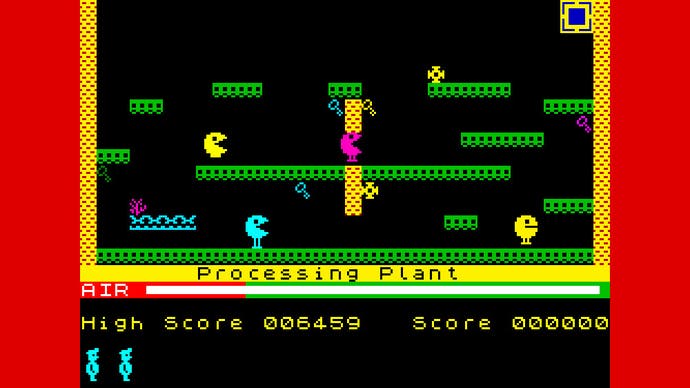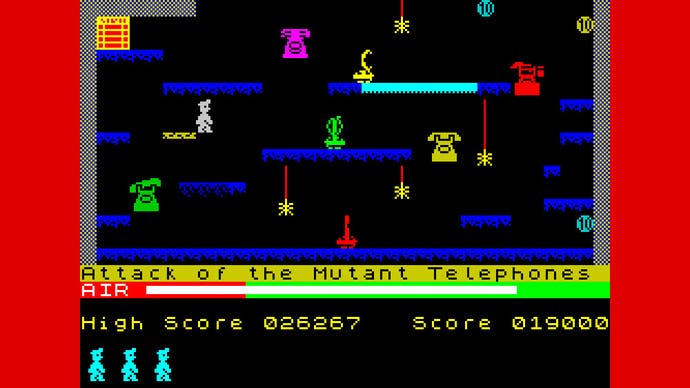Manic Miner 360: Revisiting a Classic
The Final Barrier.
I spent a lot of last week being killed by a toilet. Luckily, the toilet was an old friend, so it was hard to get too angry about it. This toilet would run towards me across the floor of the cavern, lid flailing, back pipe open to the air. Then it would hit me, and I would be dead. Squelch.
No, actually: Squich. That's the sound you hear when you die in Manic Miner, whether you're killed by the yapping lavatory of Eugene's Lair, or one of dozens of other hazards strung throughout the adventure. It's also the sound I hear when I shut my finger in a car door, drop a book on my foot, or accidentally slice myself open on a splinter of some kind. I've been living with squich for almost 29 years, I reckon, as that's roughly how long I've been living with Manic Miner.
I play it extremely infrequently these days, but that hardly matters. So much of it - and I appreciate that this sounds stupid - lives on within me. This is the reason I was so excited to try the new Xbox Live Indie Games port. It's also the reason there's no score at the bottom of this article, and that it's not really a review in the first place. What would I be scoring? Where would the review end and something else begin?

There's this, at least: to my non-technical eye, the XBLIG version's a good port of the Spectrum original. The colours still bleed over one another, staining your plucky little hero red, green, yellow, cyan as you race about and jump through platforms. The music still putters along in its short loop, making everyone within earshot inexplicably furious about the Mountain King and his stupid freakin' Hall. Death still comes with that horrible blade of sound before the boot of inevitability descends and stamps you flat, and - oh yes - it's still hard. It's still fiercely, wonderfully, improbably hard to complete.
It's still brilliant, in other words, and I really didn't think it would be. In 2012, I'm enjoying this rather reverent repackaging every bit as much as I loved the original back in the early '80s when I got one go on it out of every five. (We'd hot-seat it, see, but my older brothers both got two turns for my one because they were bigger than me and it was their computer.)
The first time I ever heard the word menagerie was because of, well, The Menagerie in Manic Miner, and it turned out to be a perfect fit - conjuring up the stately wildness that lurks at the heart of the game, and hinting at the refined, cat-lady craziness of its creation.
If you're new to it, Manic Miner is an extremely pure platformer made by Matthew Smith, a talented and eccentric British designer. Inspired by Miner 2049er, Smith created a game in which you race through single-screen levels collecting shimmering trinkets and avoiding weird, humdrum, terrifying enemies. Then you head, somewhat audaciously, back to the exit again and immediately warp to a new location.
You're Miner Willy, see, spelunking deep beneath the wilds of Surbiton, and you've found both treasures and horrors on your travels. Can you make it through each chamber before you run out of air? Can you make it back to the surface on three paltry lives?

That air meter's always felt strangely appropriate, because Manic Miner's all about atmosphere. Its environments are lurid and sinister and filled with an odd congregation of foes: penguins, ostriches, clockwork robots, shattering space stations. In a bizarre, counter-intuitive way, the very ambiguity of the glittering graphics lends everything a distinct tangibility. As a kid, I knew what those icicles felt like when I got gored through the head by one of them. I knew the juddering sting of landing on a platform after a serious drop, and knew the crumbly, biscuity texture of the ground as it collapses beneath you.
My favourite touch, though, is that each chamber comes capped with a stark, rather poetic name, like The Cold Room, The Vat, or Abandoned Uranium Workings. The first time I ever heard the word menagerie was because of, well, The Menagerie in Manic Miner, and it turned out to be a perfect fit - conjuring up the stately wildness that lurks at the heart of the game, and hinting at the refined, cat-lady craziness of its creation.
Not that it feels wild or crazy when you're jumping around, though. Anything but, in fact. Every time the platforming lets me down on some two-bit iOS title, I think of Manic Miner and its split-hair precision. I think of the deviously simple enemy paths, the pixel-perfect collision detection, the unchanging length of each leg-pedalling hop. Smith got all of this stuff right back in 1983, why can't everyone else do it now?
Manic Miner's tough but fair, as the cliché goes, and it's rewarding with it. Nothing beats the feel of jumping right over an enemy in Smith's world, timing it just so, and landing with enough of a gap to then make your getaway. I hear a little chime in my head when it happens, but the chime doesn't appear to be part of the code itself. Still, I hear it with such clarity.

What's new with Manic Miner 360? Not the game, thankfully - not as far as Ore Refinery, anyway, which remains my eternal stumbling block. It's a lovely package, though, and it's nicely put together.
In the menus you'll find a précis of the game's narrative along with a brief history of the project (I'm ashamed to admit I didn't know it was the first Spectrum title with in-game music). Additionally, you've got the option to remove the scan lines, pixel filtering and telly cabinet frame that have been placed on top of the action, and you can reverse the colour scheme in Winter Mode. You can also play with cheats enabled, giving you infinite lives and allowing you to pick up on the level where you last left off. It's a Miner Willy for a friendlier age, in some ways, but at least I'll be able to cruise through the Final Barrier this time.
I'm clouded by nostalgia, of course, but even if I came to Manic Miner cold and clear-headed today, I'm pretty sure I'd still know I was onto something special. It's an inventive, charismatic game with its flapping-mouthed toilets and reflective mirrors. It's a sad game, too, because Smith never went on to become our Miyamoto or our Eugene Jarvis, dropping out after Jet Set Willy and an attempt at a third instalment in the series. It's a reminder that the state of games publishing in Britain has meant so many of the best designers have either given up or gone overseas. They still do great work, of course, but often in the service of other visions.
Play Manic Miner today, yesterday, 29 years ago, and you see what the quintessential British computer game feels like - and you may feel a juddering sting when musing over the fact that we don't have our own Ubisoft to support this kind of thing on a large scale. Freaky, funny, slightly grown-up games. Video games, as Dan recently argued in his soapbox, that contain elements of social satire while also including the prospect of a living telephone, smacking its disgusting lips. That's what Britain did for games - and still does when it gets the chance.
Squich.

